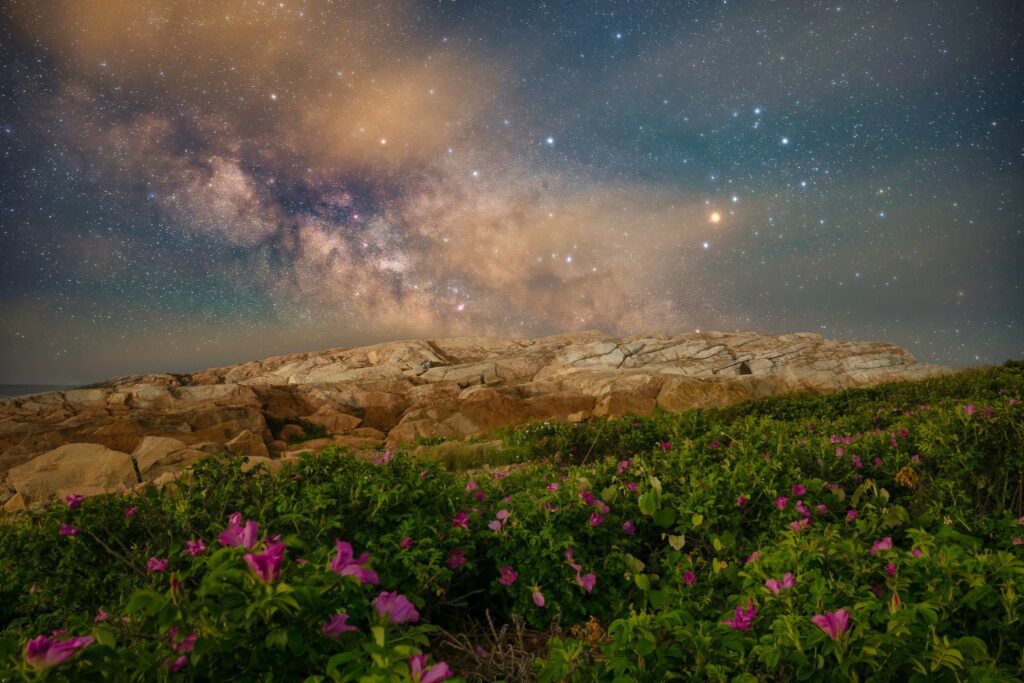
Jesse Coker is a Rhode Island photographer Motif reporter Amanda Grafe met at the Misquamicut Springfest. His photographs contain a wide array of stunning landscapes found around Rhode Island and New England that leave the viewer in awe. In certain pieces, Jesse is able to capture more than a single moment using a timelapse process, which brings history and life to his photography.
Amanda Grafe (Motif): Start by telling me about yourself.
Jesse Coker: I grew up in Exeter, and now live in South Kingstown with my wife and young son. I graduated from URI in 2005, served in the US Peace Corps (RPCV Uganda, ’10-’12), and have worked as an organic farmer in North Kingstown. My photography has been selected for a gallery showing with the South County Art Association. All my work is self-taught.
AG: What sparked your interest in photography?
JC: I bought my first DSLR camera in September of 2019 for a honeymoon in Croatia. I became passionate about photography quickly because it allows me to use my strength in mathematics for planning and executing technical images while at the same time exploring my creativity to create interesting compositions. Photography provides an opportunity for me to go on adventures, meet people, and discover unique perspectives of the natural world that I can share with our communities.
Q: What subjects do you focus on?
JC: The most interesting subjects for me have been the ocean and the night sky. The ocean is an endless source of energy, both in the way it can calm our souls and in the way it can invigorate us when we need inspiration. I love capturing these feelings and bringing them to those who can relate. Photographing the night sky provides a unique juxtaposition — it brings both a sense of clarity in what lies beyond our world, as well as a sense of pure wonderment of the unknown. The beauty of the night sky through the seasons is astounding, and I love the way today’s cameras enable us to discover for ourselves what is out there. I also love to photograph gardens and the biodiversity they contain!
AG: Where are your favorite places to photograph?
JC: My favorite places to photograph have been along the RI coastline from Narragansett to Westerly. These areas have fairly dark skies, great wave action and plenty of natural features to create interesting compositions from.
AG: What is your creative process like?
JC: I’m constantly monitoring natural processes such as the surf forecast, moon cycles, galactic positioning, weather conditions, tides, etc. and finding ways to apply these to places that captivate me. This will hopefully put me in the right place at the right time, but it always comes down to how I’m able to work with conditions on the ground and what strikes my fancy in the moment. I work with a medium format Fujifilm camera, prime lenses, tripod, star-tracking device, and an underwater housing to accomplish my goals as a photographer.
AG: Can you explain how you capture such beautiful images of the night sky?
JC: In order to bring out the best details in the night sky with a camera, long exposures are necessary. This is because there is not very much light from the stars that reaches the camera’s sensor, so the settings that one would use to produce images during the daytime create images that are almost pure black at night. Long exposures allow the sensor to collect enough light and data to produce images that are interesting to us. Single exposures with a tripod can be fairly interesting, with exposures up to about 30 seconds, depending on the lens used, before the stars begin to ‘trail’ due to the Earth’s rotation.
Even longer exposures are also possible, with the use of a star-tracking device. Once the camera is mounted onto this contraption and the tracker is aligned with the North Star, it rotates the camera opposite the Earth’s rotation, at the same precise speed. If aligned well, exposures of several minutes are attainable, making it possible to get incredibly detailed pictures of the cosmos. One side effect of this process is that because the camera is moving, the foreground becomes blurry, and so a separate exposure is taken from the same exact location and then the final images are blended together in Photoshop.
The next step that is taken to produce even better results is to take a series of exposures, one after the other, of the same part of the sky over the course of several hours. Doing this produces images that are fantastically sharp, with very little ‘noise’, and excellent clarity. My longest amount of time spent under the stars for one image was at Black Point in Narragansett – about three hours of exposure, and this has the best colors and detail of any night image I’ve taken to date.
AG: Do you have a favorite piece?
JC: I have a few favorite pieces for different reasons. Interestingly, my favorite composition that I’ve done has to be from the very first time I attempted to photograph the Milky Way over Bass Rock in Narragansett. It was mid-March of 2021 and I had spent several hours in very chilly conditions attempting to learn the process firsthand. As my fingers were numb and I was leaving for the night, I looked back and thought how sweet of a view it was from the rock I was standing upon. I fumbled through my gear to set up again, and somehow my fingers were able to press the buttons well enough to get the shot! I call it ‘Blue Hour at Bass Rock’.
AG: Where can people see your work?
JC: You can see my work on my website www.jessecokerphotography.com
I’m occasionally at the Providence Artisans Market at Lippitt Park in Providence as well. Feel free to contact me at Jets7500@gmail.com

